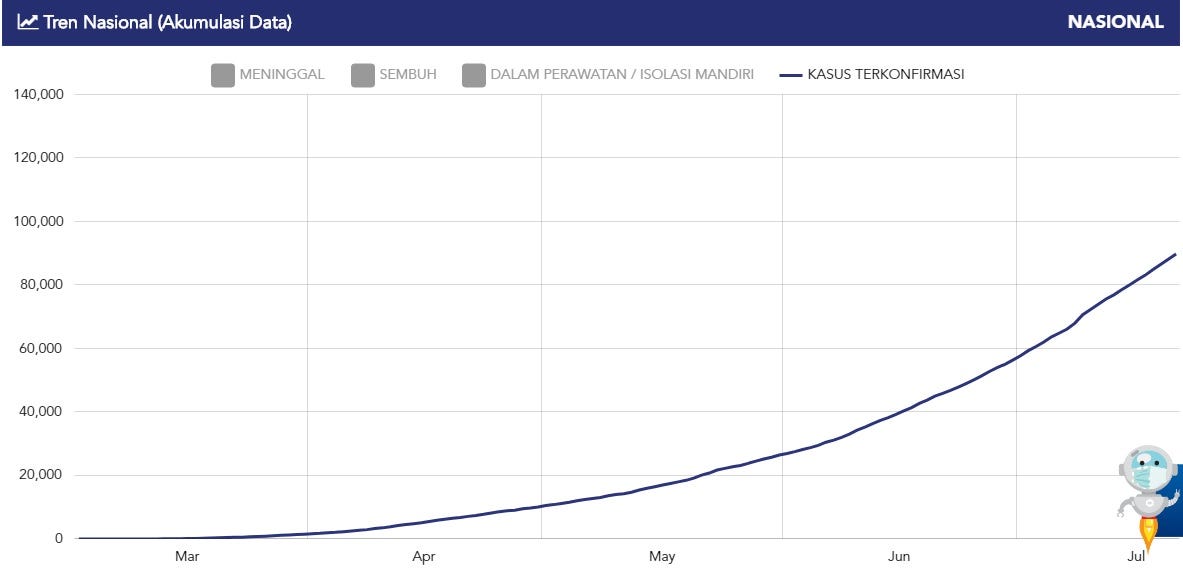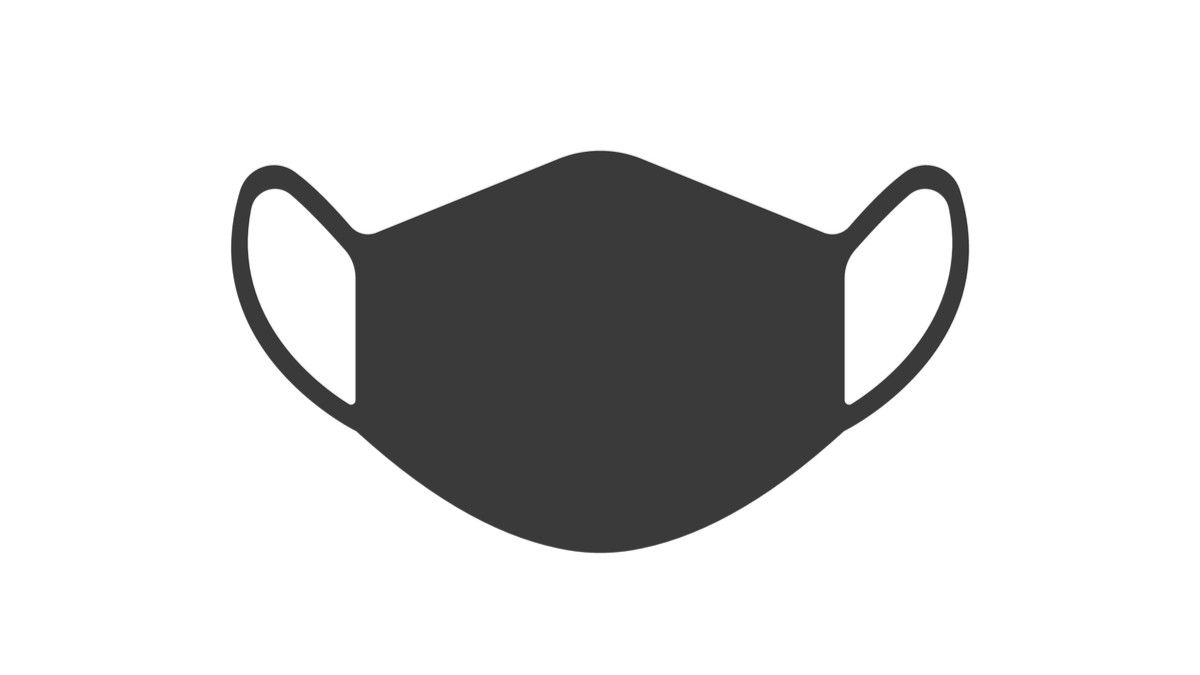COVID-19 disease has been declared as a global pandemic in March 2020 (1). The disease is caused by a novel coronavirus, SARS-CoV-2. As of July 20 2020, the total number of confirmed COVID-19 cases is about 14.3 million in more than 200 countries across the world, and 4.3% of the confirmed cases have died (2). In Southeast Asia, Indonesia is a country which has the highest number of COVID-19 cases (3). The total number of confirmed cases in Indonesia is 89,869, and 4.8% of the confirmed cases have died as of July 21, 2020 (4). The Government of Indonesia (GoI) has issued some regulations to respond to the pandemic situation. For instance, the GoI developed regulation related to quarantining COVID-19 patients, working from home, wearing a mask, personal hygiene, and physical distancing to reduce the transmission of COVID-19, but imposing full lockdown is not preferable.
The GoI argued that imposing full lockdown nationwide could severely impact Indonesia’s economy. Admittedly, implementing a full lockdown policy could lead to tremendous economic consequences for Indonesia. For instance, some business could be closed, and the unemployment rate could increase significantly due to the restriction on movement of people. This condition will urge the GoI to provide financial support for firms and individuals to prevent the collapse of the national economy and to retain people’s incomes. However, the provision of financial support requires large financial resources. For example, the federal government of Australia provides $130 billion or equal to 1.3 quadrillion rupiah for business employees as a response to the pandemic in Australia (5). The GoI may need more financial resources than Australia to keep Indonesia’s economy afloat since Indonesia has a larger population than Australia.
On the other hand, imposing full lockdown is considered as an effective method to reduce the number of new cases of COVID-19 in some countries, such as New Zealand. This is because the imposition of lockdown is considered in line with the two basic concepts of infectious disease epidemiology, which is, first, a case could be a source of a new case (6). People or organizations working on the prevention of the spread of infectious disease should be able to identify the source of a new case in order to prevent other infections. However, in the context of COVID-19, it is challenging to identify the source of the new case. This is because people could spread the virus while they are asymptomatic and they could spread the virus to between 2 and 3 other people since the estimated reproductive rate of the SARS-CoV-2 is between 2.5–3 (7). Therefore, due to difficulties in identifying the source of the new case, some countries have implemented full lockdown policy.
Indonesia seems to experience challenges in identifying the source of the new COVID-19 case. A press release about COVID-19 cases in one province in Indonesia mentions that some people who test positive to COVID-19 do not travel to a high-risk area and do not contact with COVID-19 patient (8). This fact suggests an inability to identify the source of the new case since people working in controlling the COVID-19 can not find how people get the disease. Therefore, considering the first concept of infectious disease epidemiology and the existing fact about the inability to identify the source of the new case, it is a call for the GoI to refine their strategies to reduce the COVID-19 transmission.
Second, the risk of getting a disease is affected by the disease prevalence in a population (6). For instance, if the prevalence of dengue fever is high in your area, the probability for you to be infected by the dengue virus is higher than people living in an area with a lower prevalence of the dengue fever. Based on the second concept, reducing the prevalence of an infectious disease is an effective method to reduce people’s risks of getting the disease. This is the reason why countries with high COVID-19 cases try to flatten the curve of COVID-19 by imposing full lockdown. Those countries try to reduce the prevalence of COVID-19 in their country to reduce people’s likelihood to be exposed to the virus. In Indonesia, the trend of the number of positive cases continues to increase. This indicates that Indonesia’s COVID-19 curve has not yet been flattened and each day, people have a higher risk of the disease. Despite the upward trend of COVID-19 cases, the GoI has decided to lift some restrictions and introduced a ‘new normal’ policy. Thus, based on the second concept of infectious disease epidemiology, easing the restriction in Indonesia is not a scientific-based policy to prevent and control the COVID-19.


In conclusion, it is understandable that it is challenging for Indonesia to impose lockdown due to the potential economic impacts of COVID-19. However, the existing policies need to be reviewed as they appear to be not fully effective in overcoming the pandemic. The GoI should develop scientific and evidence-based policies, and those policies should be strongly enforced to reduce the COVID-19 transmission in the country. Some regulations could be adopted to reduce the transmission, such as imposing lockdown for an area with a high case of COVID-19, implementing restriction to go outside unless to go to market, visit health services and for exercise, providing takeaway menus in restaurants, or deciding on the total number of people who can gather in one place.
References
1. World Health Organization. WHO announces COVID-19 outbreak a pandemic [Internet]. World Health Organization. 2020 [cited 2020 Jul 7]. Available from: https://www.euro.who.int/en/health-topics/health-emergencies/coronavirus-covid-19/news/news/2020/3/who-announces-covid-19-outbreak-a-pandemic
2. World Health Organization. Coronavirus disease (COVID-19) Situation Report [Internet]. Geneva, Switzerland: World Health Organization (WHO); 2020 Jul [cited 2020 Jul 21]. Report No.: 182. Available from: https://www.who.int/docs/default-source/coronaviruse/situation-reports/20200720-covid-19-sitrep-182.pdf?sfvrsn=60aabc5c_2
3. Nurbaiti A. Indonesia becomes country with most confirmed COVID-19 cases in Southeast Asia. The Jakarta Post [Internet]. 2020 Jun 17 [cited 2020 Jul 7]; Available from: https://www.thejakartapost.com/news/2020/06/17/indonesia-becomes-country-with-most-confirmed-covid-19-cases-in-southeast-asia.html
4. Gugus Tugas Percepatan Penanganan COVID-19. COVID-19 data in Indonesia [Internet]. covid19.go.id. 2020 [cited 2020 Jul 21]. Available from: https://covid19.go.id/peta-sebaran
5. Worthington. Government to subsidise your wages $1,500 per fortnight so businesses don’t sack you. ABC News Australia [Internet]. 2020 Mar 30 [cited 2020 Jul 7]; Available from: https://www.abc.net.au/news/2020-03-30/coronavirus-wage-subsidies-government-businesses-workers/12103108
6. Giesecke J. Modern Infectious Disease Epidemiology. London; 1994.
7. Aronson JK, Brassey J, Mahtan KR. “When will it be over?”: An introduction to viral reproduction numbers, R0 and Re [Internet]. University of Oxford; 2020 [cited 2020 Jul 7]. Available from: https://www.cebm.net/covid-19/when-will-it-be-over-an-introduction-to-viral-reproduction-numbers-r0-and-re/
8. The Government of West Nusa Tenggara Province. Press release COVID-19 cases in West Nusa Tenggara Provicne [Internet]. The Government of West Nusa Tenggara Province; 2020 [cited 2020 Jul 7]. Available from: https://corona.ntbprov.go.id/storage/dokumen/Press%20Release%20Update%20Covid-19%20-%206%20Juli%202020.pdf

